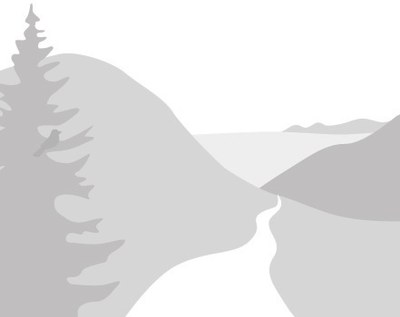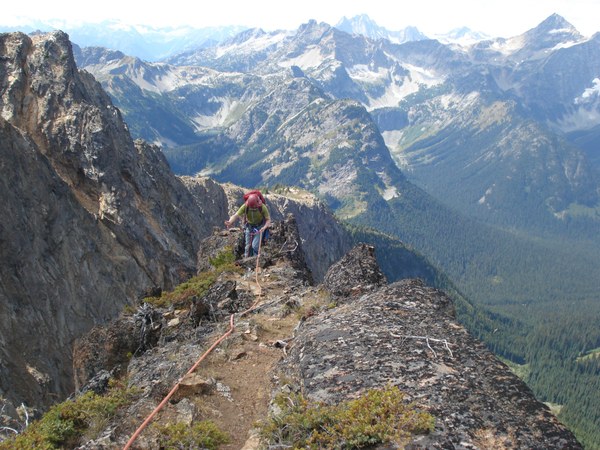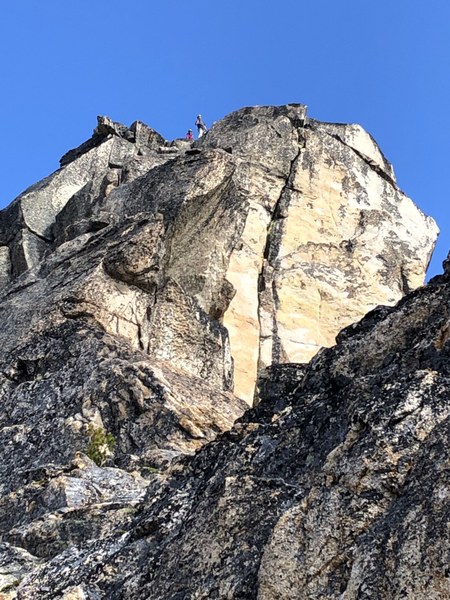
Trip Report
Cutthroat Peak/West Ridge
Not recommended as first Basic climb. Loose approach and exposure on route.
- Sat, Aug 31, 2019
- Cutthroat Peak/West Ridge
- Climbing
- Successful
-

- Road suitable for all vehicles
-
Good description of Washington Pass area and Cutthroat approach available in free sample from Supertopo:
http://www.supertopo.com/freetopos.html#wapass
Late season approach for West Ridge is through very loose terrain. Participants will need to be experienced in traveling safely on loose scree and boulders. If not, descent will require additional rappel or two, adding to descent time.
[The route description on the Mountaineers website needs to be updated...]
This climb was set up for Basic students needing rock climb credit. In hindsight, this was not a good route for a first rock climb. Late season approach is very loose and traverse atop the west ridge is very exposed, even if technical difficulty is not that high.
The team gathered at 7AM at Blue Lake trailhead, then piled into two cars to drive west 0.5 miles to road-side pullout. Parking with view of the peak through the wood turned out to be spot-on, as we found the trail down to the creek immediately below us. First part of approach hike was pleasant, if steep. As we passed the South Buttress, the trail disappeared and approach became looser. As noted in other descriptions, stay somewhat left to gain the notch at base of west ridge.
After gaining the notch, traversed on ledges 100' or so to the base of the shallow gully that heads left and up to the ridge crest. Leader realized that his previous attempt went up SW Gully, so this turned out to be a new experience for him as well.
The shallow gully is steep and loose, but not too difficult. A full rope length above, we found a ledge with new bolts and chains. Next set of bolts and chains were less than a rope length above. From there, the climb turned into a ridge traverse, with steep dropoff to both sides . Opportunity for placing rock pros were limited, though snaking the rope through some horns and other features provided some protection. Approximately three rope length later, we gained the sandy area at top of the SW gully.

The sandy ledge is a good area to regroup and rest. Guidebook offers variations on reaching the summit from this point, but for Basic level climb, recommended path is the traverse on the north west face over to the north ridge. This is nearly two rope length across yet more exposed terrain. From there, scramble to the summit for 1.5 rope length.
We had information that West Ridge can be climbed directly with the route going up and then right around the face to join up with South Ridge finish with some 5.7 sections. To avoid bottleneck, the second team chose to attempt the direct route. However, that took more time than anticipated due to rope team shuffle, so they were just below the summit when leader called for the teams to start the descent with time running out.

Rappel from summit was off two-bolt chain anchors that brought us back near start of the northwest face traverse. From there descent options are to reverse the west ridge route or to find rappel stations down the SW or next gully over. The second team followed the rappel down the gully while the first team followed the ridge back belaying back across the exposed sections. Both teams reached the base area at about the same time.
It was starting to get late as we retrieved our packs and switched back into boots. Some team members were having issues with loose scree descent, so a decision was made to rappel from the tree just below the base of the ridge. We found that it already had rappel slings on it. By the time last person started the rappel, the sun had gone down. Scramble down loose gully, then popping into the woods on climbers left took us back on more steep and loose climbers trail down. Having team members who managed to get back to the trail in daylight and shining their headlamps helped navigate the last of the team members back down to regroup. It was late and cold by that time. A lesson learned - make sure your extra clothing is in your own pack and not someone else's, especially if that person is last one down. Hiked down the trail in the dark and back to the cars after 10:30PM.
Like any other difficult outings, leader expects to forget the pain and repeat the route at some point in the future. Would it be better if approach is snow covered and team comfortable on self arrest? Who knows.
 Takeo Kuraishi
Takeo Kuraishi